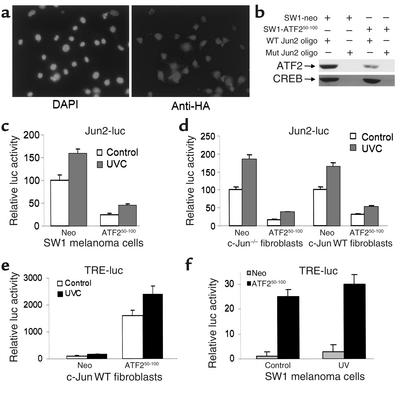Figure 1.
(a) Expression of the ATF250–100 peptide in SW1 cells. Mouse melanoma tumor-derived cells (SW1) were transfected with control or an HA-tagged ATF250–100 construct and clones were examined by immunohistochemistry using anti-HA antibodies. (b) Decreased ATF2 binding oligo bearing Jun2 motif in SW1 cells expressing ATF250–100 peptide. Nuclear proteins were incubated with biotinylated oligonucleotides bearing Jun2 motif. Oligo-bound proteins were captured on avidin-coated beads; then nonspecific bound proteins were removed by extensive washes, and bound material was subjected to analysis via Western blotting using antibodies to ATF2 and CREB. (c) Decreased Jun2-luc activity in SW1 mouse melanoma tumors expressing ATF250–100 peptide. SW1 cells that constitutively express control or ATF250–100 were transfected with the Jun2-luc and β-galactosidase (β-gal) constructs to monitor transcriptional activity of ATF2 and c-Jun. Proteins were assayed for β-gal activity and luciferase activity. Values depict relative luciferase activity normalized with respect to transfection efficiency based on β-gal assays. (d) Jun2-luc activity in Jun-null and WT cells. Shown is a Jun2-luc analysis similar to that shown in c except that the cell types used were Jun+/+ or null mouse fibroblasts. (e) TRE-luc activities in mouse fibroblast cells. Analysis of TRE-luc activities was carried out as indicated in c using mouse fibroblast cells that carry WT Jun. (f) SW1 cells expressing ATF2 peptide exhibit increased TRE-luc activity. Control and ATF2 peptide–expressing SW1 cells were transfected with the TRE-luc and β-gal constructs, and degree of TRE-mediated transcriptional activity was measured. Values were normalized per β-gal activity. DAPI, 4,6-diamino-2 phenylindole dilactate; UVC, ultraviolet-c radiation; neo, neomycin.

